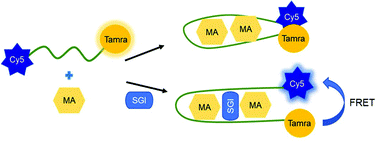SYBR Green I promotes melamine binding to poly-thymine DNA and FRET-based ratiometric sensing†
Abstract
Melamine binding to polythymine (poly-T) DNA has been widely used to develop biosensors for the detection of melamine. In this work, SYBR Green I (SGI) was used to stain the binding reaction, and using DNA melting experiments, it was confirmed that poly-T DNA formed intramolecular binding complexes to bind multiple melamine molecules. In addition, while this system was insensitive to ionic strength, longer DNA and lower pH favored the binding of melamine. A fluorescence resonance energy transfer (FRET) sensor was designed by labeling a TAMRA and a Cy5 fluorophore on the two ends of T30 DNA, respectively. In the presence of SGI, FRET-based ratiometric detection was achieved with an apparent Kd of 85 μM and a limit of detection of 10.7 μM melamine. Without SGI, the sensitivity of detection was decreased by 47-fold. Interference from Hg2+ can be masked by adding EDTA. Detection of melamine in milk was achieved with recovery rates from 87.0 to 101.7%. This study has provided both basic biochemical insights and a ratiometric sensor for highly sensitive and robust detection of melamine.

- This article is part of the themed collection: Analyst Recent HOT articles


 Please wait while we load your content...
Please wait while we load your content...